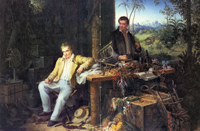| Humboldt SINQ Midterm | last modified: |
Estimated time: 2 hours of writing. If you get much beyond that, it's time to quit, because you've probably done most of what you can, no matter how much longer you take or how many words you write.
The exam has three parts (1, 2, 3 below). In part 1 you have a choice among 1a, 1b, and 1c. In part 2 you will choose an article to read. But be sure to do all three parts: 1, 2, 3.
General writing proficiency, judged wholistically from all three parts, counts 25%. Here is the scoring guide for that. Content knowledge counts 75% of the midterm grade (25% for each of the three parts below). Here is the scoring guide for that.
This exam is closed-book (and closed-other resources, other than what's in your own mind). By continuing with the exam you are declaring that you are complying with this policy.
1) Revisit your first writing activity, where you described the famous Humboldt portrait (below, left, by Weitsch). Look also at the portrait (below, middle) that was featured during week 3 of the course (two men at a table with all those scientific instruments), and the modified version (below, right) of the Weitsch portrait that appears on the cover of Helferich's biography of Humboldt. Click on the images below to view the images enlarged (or just look at your book's [closed!] cover).
 |
 |
Now write about YOUR CHOICE of topics 1a, 1b, OR 1c:
a) Comment about your understanding, ’way back in week 1, of the Weitsch portrait, compared with what you understand about the portrait now. It's OK to mention what you got right from the very start. If somehow you didn't do that initial assignment, do for the present either 1b or 1c, and then soon do the first "portrait" assignment (it's timed at just 20 minutes).
b) Identify the people and the place in the second portrait. Compare it to the Weitsch portrait, both as a work of art (color, organization, poses, etc.) and as an attempt to convey meaning about people, things, and ideas. What scientific instruments are those in the picture? What did those men observe or measure with them? How much of that science (quantity, variety) did they do? Where did they travel to do their work? How did they get their results back to "civilization"? Liven up your comments with some exciting or at least interesting stories of their experiences doing "extreme" science and exploration, just in case Hollywood wants us to consult on their film, Alex of the Jungle (sequels: Crocodile Humboldt, Humboldt in the Land of Smoking Volcanoes, Humboldt and the Man-Eating Piranhas of the Amazon, Humboldt at the Top of the World, Dances with Jaguars, and on and on). Don't underestimate the power of the "yuk" factor, but go easy on the "ewww".
c) Compare the Weitsch portrait (above left) to the cover of the Helferich biography (above right). What was the cover designer's aim in changing and augmenting the portrait, and how well does that cover "work"?
2) Choose ONE of the attached articles (if there is more than one), read it, and relate it to Humboldt and (NOT "or") sustainable environmentalism. Humboldt would doubtless jump right into the activities and discussions those articles present and, in his charmingly accented English (French accent? German accent?) argue the ideas or help with the research. What could he offer? Along the way you should state your concept of sustainable environmentalism.
3) Tell how a skill, interest, or academic capability of yours relates to what you're learning about Humboldt and how it could be used, in combination with your knowledge of Humboldt's life and work, to help others learn something. That "something" can be about sustainable environmentalism, but does not have to be, and it does not have to be learning something specifically about Humboldt. Those "others" could be schoolchildren, professors in your other classes, politicians, or your fellow citizens around the country or around the globe.
Just as science needs not only ideas but data, your writing needs not only ideas but facts and examples.
<